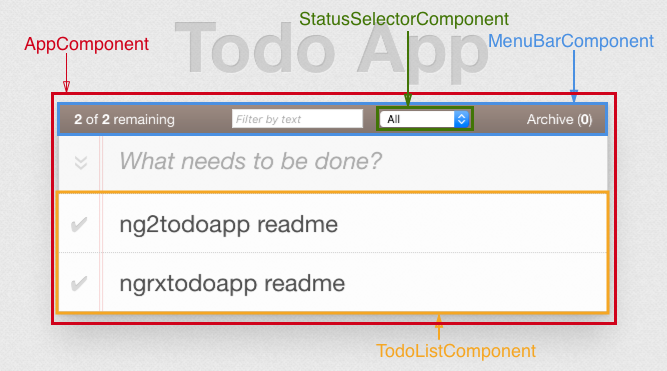Introduction
Before anything, I would like to say that english is not my mother tongue. I speak french. So be nice :-)
Feel free to email me or to leave a comment if you see any kind of mistake. I’ll appreciate it. Thanks.
I did the classical todo app in angular 2. You can test the work by clicking on this:
view app
The project is on github: sources
By the time I’m writing this post, angular 2 is still in release candidate version. So my goal was to play with this new framework by making a somewhat useful project.
Getting Started
Make sure you have have NodeJS and Git installed on your machine. Then do this:
42sh> # install webpack, webpack-dev-server and typings globally
42sh> npm i -g webpack webpack-dev-server typings
42sh> git clone https://github.com/kgosse/ng2todoapp.git
42sh> cd ng2todoapp
42sh> npm i
42sh> npm startIf everything is ok, open your browser and go to: localhost:8080
Components
Here is how the user interface is structured :

The application’s logic
A todo is represented by this class :
// src/store/index.js
export class Todo {
done: Boolean;
editing: Boolean;
private _text: String;
get text() {
return this._text;
}
set text(value: String) {
this._text = value.trim();
}
constructor(text: String) {
this.done = false;
this.editing = false;
this.text = text.trim();
}
}Then we have the TodoStore class to manage all the todos:
// src/store/index.ts
export class TodoStore {
todos: Array<Todo>;
constructor() {
//...
}
private getTasks(done: Boolean) {
//...
}
updateStore() {
//...
}
removeDoneTasks() {
//...
}
getRemaining() {
//...
}
getDoneTasks() {
//...
}
toggleTask(todo: Todo) {
//...
}
add(todo: Todo) {
//...
}
toggleAll() {
//...
}
remove(todo: Todo) {
//...
}
}Finally, I have created a service (src/services/todo.services.ts) which is injected in all the components. Notice that this service is the only way for the components to interact with the TodoStore. The thing I like the most with this service is that it helps synchronising the application’s state between the components. Consider the following case: The user decides to show only the remaining todos by selecting the appropriate status in the select input. How to make the TodoListComponent refresh its content according to the new status selected ? My solution was to add an EventEmitter member attribute inside the TodoService. As it is injected in all the components, they can subscribe to that attribute (todoEvent) in order to listen and handle emitted actions and also use it to emit their own actions. That way, when the StatusSelector component emit an action (STATUS_CHANGE) for a change inside the select input, here is how this one is handled inside the TodoList component :
// src/components/todo-list.ts
constructor(private _todoService: TodoService){
this._todoService.todoEvent.subscribe((action:Action) => {
switch (action.type) {
case ARCHIVE:
this.getTodos();
break;
case STATUS_CHANGE:
if (action.payload === ALL)
this.getTodos();
this._status = action.payload;
break;
case TEXT_CHANGE:
this._text = action.payload;
break;
}
});
}Useful Links
Conclusion
Angular 2 is a very interesting framework. It comes with all the things to let you have a very solid MVC structure (like angular 1). But, since I have started developing apps using flux pattern thanks to React, I fell in love with it. That’s why, even if this app is working properly, I’m going to make another version of it in flux and Redux way. Thanks for reading :-)